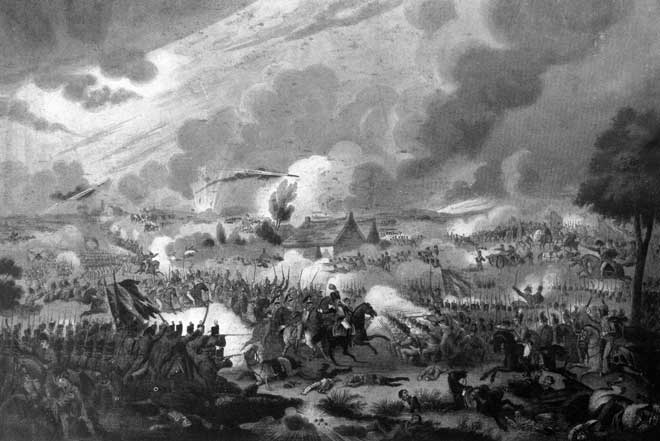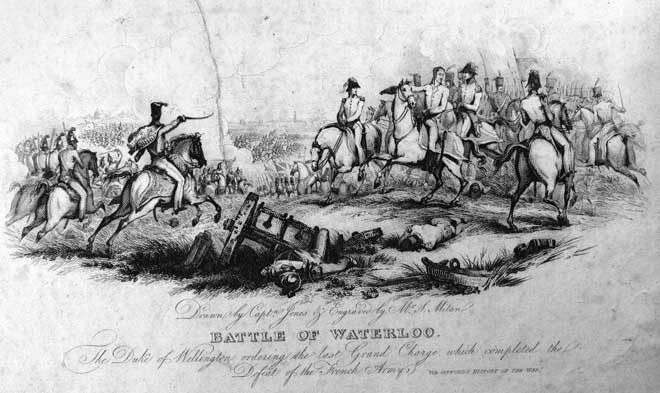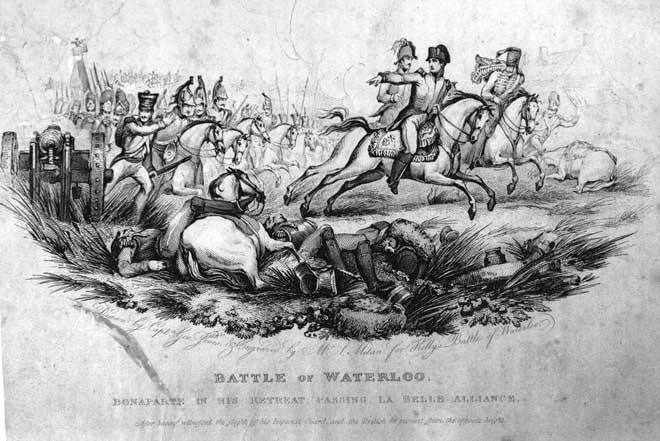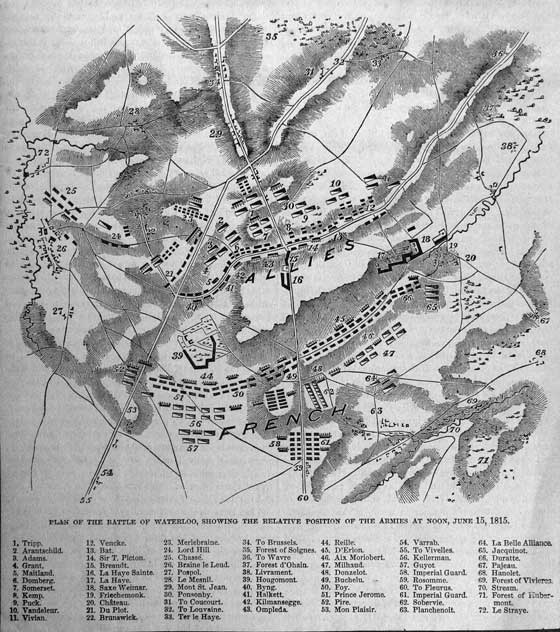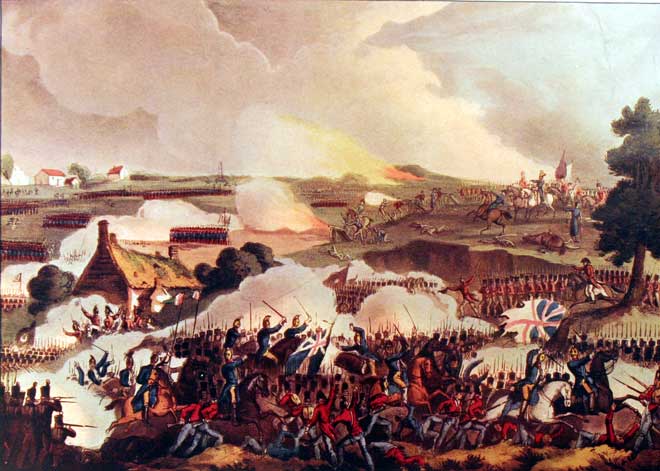 |
King's Own Royal Regiment Museum Lancaster |
|
|
HOME Museum & Collections Soldiers of the Regiment Sales Donations Events Contact Us REGIMENTAL HISTORY 17th Century 18th Century 19th Century 20th Century First World War Second World War Actions & Movements Battle Honours FAMILY HISTORY Resources Further Reading PHOTO GALLERY ENQUIRIES FURTHER READING LINKS |
Regimental History - 19th Century The King's Own at Waterloo on 18th June 1815 In March 1815 Napoleon escaped from the Island of Elba, and seized the Government of France. The other European Powers at once formed Armies to overthrow him. England had despatched most of her old Peninsular Regiments, and among the the Fourth, The King's Own, to the American War, which, however, had at this moment just been terminated. Wellington was, of course, desirous of having as many of his old soldiers as possible, and transports were immediately despatched to bring them as quickly as practicable to Belgium. In those days, however, to cross the Atlantic in a slow sailing transport took as many weeks as a Cunarder now takes days. The transport of the 4th King's Own, out-stripping all the others, arrived off Antwerp about the 12th June. The clothing and boots of both officers and men are described by the papers of day as "in a most deplorable condition," no opportunity having been afforded the Regiment to re-fit on coming off the American Campaign. The Regiment was very weak also in numbers, and had no Field Officer but the Colonel. Their spirit, however, was excellent, and all the men had been through one or two campaigns. After landing, The King's Own marched to Ghent, and were there formed into the 10th Brigade, under Sir John Lambert. The Brigade consisted of The King's Own, Inniskillings, and the 40th Regiment. On the 16th June, was fought the battle of Quatre Bras, and Wellington, then falling back to a position near Waterloo, sent directions to Lambert to join him there. The march from Ghent to Waterloo cannot be a yard under forty-eight miles, even by the present roads. We know that the transport, which was hired, bolted from the main body (the Belgians making sure that Napoleon would thrash the English as he had all the other nations), and consequently the 10th Brigade also had probably to trust to very much what they had in the haversacks, and what could be picked up along the road. N.B. - We may be sure our old Corps was not bad at this, having had a good training in Spain and America. The roads also were either ankle deep in dust, unless the thunderstorm which fell at Quatre Bras had fallen too, when they would be excessively heavily. Our own boots, I have said, were in a very bad condition. Despite all these difficulties, Lieut. Brown, of The King's Own, says, "we arrived about half-past eight o'clock, on the morning of the 18th June, band playing, colours flying." (Not bad marching, 48 miles along bad roads, in about 30 hours at the most.) Wellington had taken up his position in three lines, on the top of a gentle rise, holding two farm houses - Le Haie Sainte and Hougomont - to the front of the position. Neither the space nor time at my disposal will allow of describing the battle, which much be read elsewhere. What The King's Own did was as follows: "The Tenth Brigade, under Colonel Brook, of The King's Own (Sir John Lambert having been sent to command a Division), took up a position in rear of the centre of the line behind the farm of Mont St. Jean. After the Union Brigade had charged the French columns, who had been retiring repulsed by Picton's Division, the Tenth Brigade moved up to the rear of Picton supporting him,, and about three o'clock came up into the front line. The farm in the front of the English line, called La Haie Sainte, was now captured by the French, and their skirmishers came on up to within two hundred yards of the Tenth Brigade, which became exposed to a most destructive fire. The Fourth with the 95th was extended in line along the Havre Road. The 40th behind the road, and the 27th Iniskillings in square on our left flank. The French crowd of skirmishers on the other side of the road, seeing this formation of the 27th, opened such a close and deadly fire on them that they lost, in a few minutes, more than half their number." About seven o'clock, the French Imperial Guard attacked the English left, who repulsed them, and then Wellington ordered a general advance, the Prussians, under Bulow, carrying the French right. Lambert's Brigade occupied La Haie Sainte. The French, thoroughly demoralized and hotly pursued by the Prussian Cavalry, fled throughout the night and never fought again, Waterloo ending the Campaign. Parade strength at Waterloo. Officers - 1 Field Officer, 2 Captains, 20 Subalterns, and 4 Staff. Non-commissioned officers and file - 36 sergeants, 11 drummers and 596 Privates. Loss in Action - 10 Officers, 114 Men killed and wounded. The Fourth went on to Paris and won golden opinions for its behaviour and smartness during three years it remained in France.
The above lines were written some ten years ago [circa 1890], and I take this opportunity of having them reprinted and distributed in memory of the writer, Lieutenant Colonel John Moore Gawne, The King's Own Regiment, a good and true Soldier, who has set us all an example of what a soldier should be, by his devotion to his duty, his care of his men, and the gallant manner in which he died for his Queen and Country. J. ROWLANDSON, Lieutenant Colonel Commanding, 1st Battalion, The King's Own Regiment. 18th June 1901.
Note: Lieutenant Colonel John Moore Gawne died on 12th December 1900 of wounds received on 11th December on 'Lancaster Hill', Vryheid, South Africa, whilst in command of the 2nd Battalion, King's Own Royal Lancaster Regiment.
We recommend The King's Own The Story of a Royal Regiment Volume 2 1814-1914 by Colonel Lionel I Cowper - the best history of the King's Own. On a CD-rom, viewable through a computer. Price including UK postage £12.75 |

